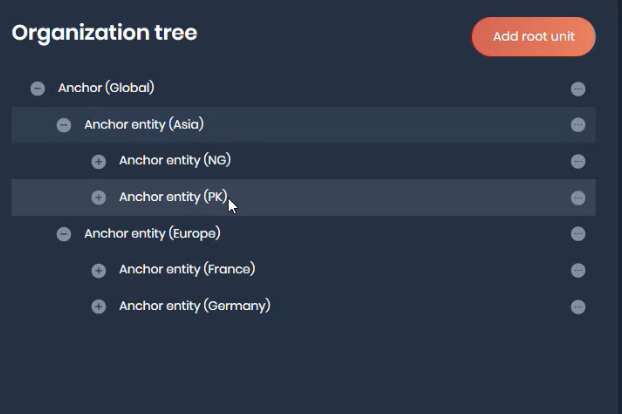Team - We need to create a new access management system that can control Data (for example customers) visibility on hierarchical users (Mapped to BusinessUnits). parent user can see all the Data (customer(s)) that belong to the user's BusinessUnits and its children's BusinessUnits as well
For Example
 Use Case 1 - Anchor-Global can access and see all customer(s) data.
Use Case 2 - Anchor-Asia can access and see only customer(s) related to NG and PK data.
Use Case 3 - Anchor-Europe users can access and see only customer(s) related to France and Germany data.
Use Case 1 - Anchor-Global can access and see all customer(s) data.
Use Case 2 - Anchor-Asia can access and see only customer(s) related to NG and PK data.
Use Case 3 - Anchor-Europe users can access and see only customer(s) related to France and Germany data.
Need your input or any references for the same. Your help will be appreciated in this regard.
- ABP Framework version: v7.3.0
- UI Type: Angular
- Database System: EF Core (PostgreSQL)
- Tiered (for MVC) or Auth Server Separated (for Angular): yes
- Exception message and full stack trace: Need your input or any sample code for the given requirement.
- Steps to reproduce the issue:
15 Answer(s)
-
0
Hello,
Please check if it`s helps you https://support.abp.io/QA/Questions/641/Organizational-Units-restricted-access-and-data-filtering
Thanks.
-
0
Hello,
Please check if it`s helps you https://support.abp.io/QA/Questions/641/Organizational-Units-restricted-access-and-data-filtering
Thanks.
Can we have a quick call?, I need to discuss my requirements in detail please share your email id. I will setup a quick connect for the same.
-
0
I am assigning this to @maliming.
-
0
hi arvind.srivastava.tas
You can refer to the
OrganizationUnitimplementation for your needs. It filters sub-items bycode// <summary> /// Hierarchical Code of this organization unit. /// Example: "00001.00042.00005". /// This is a unique code for an OrganizationUnit. /// It's changeable if OU hierarchy is changed. /// </summary> public virtual string Code { get; internal set; }https://github.com/abpframework/abp/blob/dev/modules/identity/src/Volo.Abp.Identity.Domain/Volo/Abp/Identity/OrganizationUnit.cs https://github.com/abpframework/abp/blob/dev/modules/identity/src/Volo.Abp.Identity.Domain/Volo/Abp/Identity/OrganizationUnitManager.cs#L151
and you also check the code from https://github.com/maliming/Owl.GeneralTree
-
0
https://github.com/maliming/Owl.GeneralTree
Can we have a quick call?, I need to discuss my requirements in detail please share your email id.
-
0
hi
You can send your detailed requirements to liming.ma@volosoft.com
I only provide email support. Thanks
-
0
Can you please help me out, get any idea to add OUcode filter logic in the Repository for data (Customers) segregation based on mapped User(s).
Requirement - We need to filter data based of user's OUcode
-
0
hi
https://docs.abp.io/en/abp/latest/Data-Filtering https://docs.abp.io/en/abp/latest/Data-Filtering#entityframework-core https://learn.microsoft.com/en-us/ef/core/querying/filters
-
0
In inorder to filter these BusinessUnits mapped users, We have to add a new column "BusinessUnits Code" under all data such as "Customers" and, "Invoices" and then we can take the login user BusinessUnits code and filter it accordingly.
Is there any other way around to avoid creating new new column "BusinessUnits Code" in all transactional data tables?
please see if we connect and discus this in detail, Please share your email id.
-
0
-
0
We were trying to avoid any changes (not adding a new column and no intermediate table) in transactional data tables such as "Customers" and, "Invoices" because these data tables sit in separate microservices and databases, and where BusinessUnits data sit in Tenant_Admin Database.
-
0
hi
You can use the ID(guide) of "Customers" and "Invoices" in the Tenant_Admin Database without creating a relationship.
Different microservices may use different databases. It is not possible to create database relationships. So using ID is an option
-
0
Can you share any boilerplate code to explain ID(guide)?
-
0
Any update on this? Please treat this urgent requirement, We are a licensed subscriber for ABP.IO, Please see if we can have a quick connect.
-
0
hi
ID(guid)
It's the value of the primary key. You just need to store it in the Tenant_Admin Database and then query some entities based on it.
Microservice A, table: Customers , database: DB1 | Guid | Name | | --- | --- | | 3ce8f395-2f9b-4531-b02f-ae702c2f4dbf | C1 | | 886446c2-a5b1-4f3c-ac54-c81d02e5fe71 | C2 |
Microservice B, table: BusinessUnits , database: DB2 | BusinessUnits Guid | BusinessUnits Code | --- | --- | | bd749c47-d05f-4cd7-a705-a4c27dddfd07 | 00001 | | 8ce29410-6ed1-4fc7-910f-5046a311ce07 | 00002 |
Microservice B, table: BusinessUnitsAndCustomer , database: DB2 | Customers Guid | BusinessUnits Guid | --- | --- | | 3ce8f395-2f9b-4531-b02f-ae702c2f4dbf | bd749c47-d05f-4cd7-a705-a4c27dddfd07 | | 886446c2-a5b1-4f3c-ac54-c81d02e5fe71 | 8ce29410-6ed1-4fc7-910f-5046a311ce07 |


























































